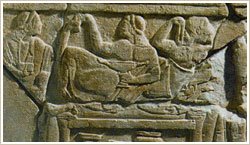Chianti Classico
written by David Anderson limited rights reserved ViewItaly.blogspot.com
 Chianti appears for the first time in registered documents in 1404 however, this area was inhabited by the Etruscans. A study of the artifacts found indicates that they were producing wine long before this date. This wine was so well known that in 1716 the Grand Duke of Tuscany Cosimo III decided to protect the name with a decree defining the zone in which the grape could be cultivated and the method of production. This was the first initiative of this type preceding future DOC denominations by 200 years.
Chianti appears for the first time in registered documents in 1404 however, this area was inhabited by the Etruscans. A study of the artifacts found indicates that they were producing wine long before this date. This wine was so well known that in 1716 the Grand Duke of Tuscany Cosimo III decided to protect the name with a decree defining the zone in which the grape could be cultivated and the method of production. This was the first initiative of this type preceding future DOC denominations by 200 years.Today, because of the notoriety of Chianti, six bordering areas to the original Chianti were allowed to produce Chianti wines. To differentiate between the original Chianti and the more general Chianti, with a ministerial decree in 1932 the name Chianti Classico was defined as only the original area.
 To acquire this name it is sufficient that the grapes are grown and transformed into wine in the original area. It is also necessary that a minimum of 75%, of the grapes used, are Sangiovese. The remaining grapes must also be grown locally but may be "Bacca Rossa", "Canaiolo" (up to 10%), "Trebbiano", "Malvisa" (up to 6%), and Merlot. Every producer will use different percentages of grapes and methods of aging however most Chianti will have a ruby red color that will tend to become red garnets with aging, an aroma of spices and wild berries, a good base structure without dominating tannins and a velvety finish.
To acquire this name it is sufficient that the grapes are grown and transformed into wine in the original area. It is also necessary that a minimum of 75%, of the grapes used, are Sangiovese. The remaining grapes must also be grown locally but may be "Bacca Rossa", "Canaiolo" (up to 10%), "Trebbiano", "Malvisa" (up to 6%), and Merlot. Every producer will use different percentages of grapes and methods of aging however most Chianti will have a ruby red color that will tend to become red garnets with aging, an aroma of spices and wild berries, a good base structure without dominating tannins and a velvety finish.Chianti is a great dinner/table wine. It does not need aging and can be served within a year of bottling that occurs in March. It will support a several of years in a controlled environment but is best when within two years of bottling.
Grape: At least 75% Sangiovese
Color: Bright Ruby Red, with aging will become garnet red with orange highlights
Bouquet: Wild Berries and earthy tones.
Flavor: A good balance of flavors, dry, and with a distinct taste of tannins. The finish is soft and velvety.
Alcohol Content: 12 - 12.5 %
Serving Temperature: 18-20 c.
Aging: 1 year
Decanting: not necessary.
 Pouring: No special conditions to follow.
Pouring: No special conditions to follow.Glass: Just about any glass will do, best with a red wine glass.
Note: Great table wine. This is a marvelous wine with just about any savory dinner. Some producers have developed interesting mixes resulting in various flavors. This is a great every day wine!
Tags: Chianti Food and Wine Tuscany Italy
Labels: Chianti, Italian Wine, Red Wine, Tuscany, Wine Vacations, Wineries



6 Comments:
mmm...i bet a good chianti would be way better than the per' e' palummo i just drank with dinner...
12:47 PM
Tracie b. - the Tuscany wines are always a good, and most importantly, safe choice. They do know wines.
I have another place that you need to try in Naples. I took some friends when they were visiting us and they had a great time.
Ristorante la Canzuncella di Aurelio Fierro. Unfortunately he died a couple of years ago but was performing right till the end. The restaurant should still offer live folkloristic music during dinner.
Let me know.
1:43 PM
Chianti is one of my favourites. I know it doesn't always come in the straw bottle (fiasco?) but it's so romantic having that on the table!
4:53 PM
Chickybabe - You have good taste!
I remember when wine meant the teardrop bottles with the straw covering. We have come a long way.
6:44 AM
i'll let you know...i think mala femina is in the works!
1:52 PM
You will enjoy it. Be ready for dancing on the tables till early in the morning!
2:07 PM
Post a Comment
<< Home